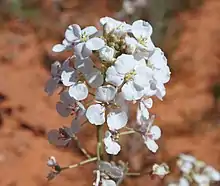Dimorphocarpa wislizeni
Dimorphocarpa wislizeni, commonly known as spectacle pod, Wislizeni's spectaclepod, and touristplant, is a flowering plant in the mustard family native to western North America, where it occurs in the southwestern United States as far east as Oklahoma and Texas, and Baja California, Sonora,[1] Chihuahua, and Coahuila in Mexico.[2]
| Dimorphocarpa wislizeni | |
|---|---|
 | |
| Scientific classification | |
| Kingdom: | Plantae |
| Clade: | Tracheophytes |
| Clade: | Angiosperms |
| Clade: | Eudicots |
| Clade: | Rosids |
| Order: | Brassicales |
| Family: | Brassicaceae |
| Genus: | Dimorphocarpa |
| Species: | D. wislizeni |
| Binomial name | |
| Dimorphocarpa wislizeni | |
| Synonyms | |
|
Dithyrea griffithsii Woot. & Standl. | |
Description
This species is an annual herb with a branching or unbranched stem 10 to 80 centimeters tall. The basal leaves are lance-shaped with toothed or lobed edges. Leaves higher on the stem are narrower, with less divided or smooth edges. The flowers have white or lavender petals 4 to 8 millimeters long. The fruit is a double-lobed, winged silicle that breaks in half at maturity, each lobe carrying a flat seed 2 or 3 millimeters wide.[2]
The plant grows in sandy and sandstone substrates[2] in desert shrubland, pinyon-juniper, and ponderosa pine associations.[3]
The seed pods of Dimorphocarpa wislizeni are flat, green, two-lobed capsules that superficially resemble spectacles, hence the common name. This feature makes identification of Spectacle Pod easy.
Uses
The Zuni people applied a warm infusion of the pulverized plant to swelling, especially the throat. A decoction of entire plant was given for delirium.[4] An infusion of the plant was taken by men to "loosen their tongues so they may talk like fools and drunken men."[5] The flower and fruit eaten as an emetic for stomachaches.[6]
References
- "Dimorphocarpa wislizeni". Germplasm Resources Information Network (GRIN). Agricultural Research Service (ARS), United States Department of Agriculture (USDA). Retrieved 25 January 2018.
- Dimorphocarpa wislizeni. Flora of North America.
- Dimorphocarpa wislizeni. NatureServe. 2012.
- Stevenson, M. C. 1915. Ethnobotany of the Zuni Indians. SI-BAE Annual Report #30 (p.48-49)
- Stevenson, p.91
- Camazine, S. and R. A. Bye. 1980. A study of the medical ethnobotany of the Zuni Indians of New Mexico. Journal of Ethnopharmacology 2 365-88. (p.375)
| Wikimedia Commons has media related to Dimorphocarpa wislizeni. |

